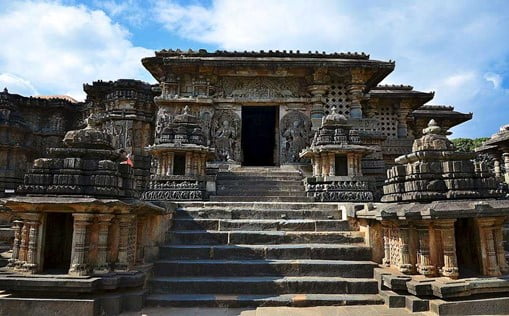History and Art and Culture
In News: An expert team will visit the Hoysala temples at Belur, Halebid and Samanathpur this week before submitting a report to UNESCO ahead of declaring them as World Heritage Site.
- This includes Chennakeshava temple at Belur, The Hoysaleshwara temple at Halebid (together “The Sacred Ensembles of the Hoysalas”) and the 13th centure Keshava temple at Somnathpur.

Criteria for declaration as World Heritage Site by UNESCO
Nominated sites must be of “outstanding universal value” and must meet at least one of the following ten criteria
- To represent a masterpiece of human creative genius
- To exhibit an important interchange of human values, over a span of time or within a cultural area of the world, on developments in architecture or technology, monumental arts, town-planning or landscape design
- To bear a unique or at least exceptional testimony to a cultural tradition or to a civilization which is living, or which has disappeared
- To be an outstanding example of a type of building, architectural or technological ensemble or landscape which illustrates (a) significant stage(s) in human history”
- To be an outstanding example of a traditional human settlement, land-use, or sea-use which is representative of a culture (or cultures), or human interaction with the environment especially when it has become vulnerable under the impact of irreversible change
- To be directly or tangibly associated with events or living traditions, with ideas, or with beliefs, with artistic and literary works of outstanding universal significance
- To contain superlative natural phenomena or areas of exceptional natural beauty and aesthetic importance
- To be outstanding examples representing major stages of earth’s history, including the record of life, significant on-going geological processes in the development of landforms, or significant geomorphic or physiographic features
- To be outstanding examples representing significant on-going ecological and biological processes in the evolution and development of terrestrial, fresh water, coastal and marine ecosystems and communities of plants and animals
- To contain the most important and significant natural habitats for in-situ conservation of biological diversity, including those containing threatened species of outstanding universal value from the point of view of science or conservation.
Salient features of Hoysala form of Architecture:
- Hoysala temples are hybrid or vesara style temples because of amalgamation of Dravidian and Nagara styles.
- Multiple shrines of different deities around a central pillared hall.
- Stellate plan wherein the shrines are established intricately in the design of a star.
- Soft soapstone being the main building material.
- Decoration of the temple through sculptures – Both the interior and exterior walls, even the pieces of jewellery worn by the deities were intricately carved.
- Upraised platform known as Jagati.
- The walls and stairs of the temple followed a zigzag pattern.
Chennakeshava temple of Somnathpur, Karnataka
- It is a Vaishnava Hindu temple on the banks of River Kaveri
- The temple was constructed in 1258 CE by Somanatha Dandanayaka, a general of the Hoysala King Narasimha III.
- The ornate temple is a model illustration of the Hoysala architecture. T
- The temple is enclosed in a courtyard with a pillared corridor of small shrines (damaged).
- The main temple in the centre is on a high star-shaped platform with three symmetrical sanctums (garbha-griha). The sanctums share a common community hall (sabha-mandapa) with many pillars.
- The outer walls, the inner walls, the pillars and the ceiling of the temple are intricately carved with theological iconography of Hinduism and display Ramayana, the Mahabharata and Bhagavata Purana
International Commission on Monuments and Sites (ICOMOS):
- It is a professional association that works for the conservation and protection of cultural heritage places around the world.
- Headquartered in Charenton-le-Pont, France, ICOMOS was founded in 1965 in Warsaw as a result of the Venice Charter of 1964, and offers advice to UNESCO on World Heritage Sites.
- Objectives: Restoration of historic buildings and protect the world’s cultural heritage threatened by wars and natural disasters under “Blue Shield”; of which ICOMOS is a partner and founding member
Source: The Hindu
Previous Year Question
Q.1) Building ‘Kalyaana Mandapas’ was a notable feature in the temple construction in the kingdom of
- Chalukya
- Chandela
- Rashtrakuta
- Vijayanagara














